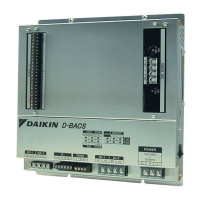212 1.10 Functions
Interface for Use in BACnet
®
1.10 Functions
1.10.1 Air Conditioner Monitor / Control Items
The table below lists the air conditioner items that can be monitored and controlled via the BACnet communication.
Note :
1. The room temperature is measured with the suction air. Since the indoor unit fan stops when the thermostat is
disabled or the air conditioner is stopped, or in a special operation such as defrosting, temperature measurement may
be affected by the heat exchanger, and may detect and transmit a different temperature from the actual room
temperature.
For this reason, this value should be considered as a reference for the room temperature.
If the building management system manufacturer uses this value for system control (e.g., switching the air-
conditioning mode or preset temperature), the manufacturer must take on the whole responsibility.
2. The air conditioner saves the settings for the temperature, start / stop status, air-conditioning mode, air direction, and
air flow rate in the nonvolatile memory each time they are changed, so that the settings will not be lost when a power
cut occurs.
This nonvolatile memory has a write count limit and may cause a failure if it is written exceeding the limit count.
Therefore when the temperature, start / stop status, air-conditioning mode, air direction, and air flow rate of each
indoor unit are automatically controlled from the central monitoring panel, be sure that the number of changes for each
setting should not exceed 7,000 times per year
.
Function Description
Monitor
Start / stop status Monitors the start / stop status of the air conditioner.
Alarm Monitors whether or not the air conditioner is operating normally, and issues an alarm if
the air conditioner has a malfunction.
Malfunction code Displays a malfunction code specified by the manufacturer if an air conditioner in the
system has a malfunction.
Air-conditioning mode Monitors if the air conditioner is cooling, heating, or ventilating.
Room temperature (Note 1) Monitors and displays the room temperature.
Filter sign Checks if the filter is clogged and monitors whether or not it can still be used.
Thermostat status Monitors whether or not the air conditioner is properly controlling the temperature.
Compressor status Monitors if the compressor of the outdoor unit connected to the indoor unit is properly
operating.
Indoor fan status Monitors if the indoor unit's fan is properly operating.
Heater operation status Monitors if the indoor unit's heater is properly operating.
Accumulated power Outputs indoor unit's accumulated power consumption.
Operation, configuration, and monitoring
Start / stop operation (Note 2) Starts / stops the air conditioner and monitors the result.
Air-conditioning mode setting (Note 2) Sets the cooling / heating / ventilating / auto air-conditioning mode and monitors the
result.
Room temperature setting (Note 2) Sets the room temperature of the air conditioner and monitors the result.
Filter sign and reset Checks if the filter is clogged and resets the status as required.
Remote controller enable / disable Enables or disables the remote controller so that it can or cannot be used to control the
air conditioner's start / stop / air-conditioning mode / room temperature.
Lower central device operation enable /
disable
Enables or disables operation of a central device connected to the DIII-NETwork.
Air flow rate setting (Note 2) Sets the air flow rate and monitors the result.
Air direction setting (Note 2) Sets the air direction and monitors the result.
Forced system stop In response to the forced stop command, checks whether clearance or setting is required
and performs the required action.
Forced thermostat disable In response to the forced thermostat disable command, checks whether clearance or
setting is required and performs the required action.
Energy saving In response to the energy saving command, checks whether clearance or setting is
required and performs the required action.

